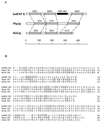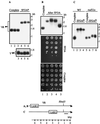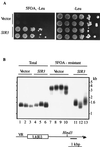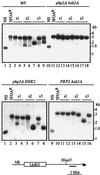Yeast hnRNP K-like genes are involved in regulation of the telomeric position effect and telomere length
- PMID: 11739741
- PMCID: PMC134203
- DOI: 10.1128/MCB.22.1.286-297.2002
Yeast hnRNP K-like genes are involved in regulation of the telomeric position effect and telomere length
Abstract
Mammalian heterogeneous nuclear ribonucleoprotein K (hnRNP K) is an RNA- and DNA-binding protein implicated in the regulation of gene expression processes. To better understand its function, we studied two Saccharomyces cerevisiae homologues of the human hnRNP K, PBP2 and HEK2 (heterogeneous nuclear RNP K-like gene). pbp2Delta and hek2Delta mutations inhibited expression of a marker gene that was inserted near telomere but not at internal chromosomal locations. The telomere proximal to the ectopic marker gene became longer, while most of the other telomeres were not altered in the double mutant cells. We provide evidence that telomere elongation might be the primary event that causes enhanced silencing of an adjacent reporter gene. The telomere lengthening could, in part, be explained by the inhibitory effect of hek2Delta mutation on the telomeric rapid deletion pathway. Hek2p was detected in a complex with chromosome regions proximal to the affected telomere, suggesting a direct involvement of this protein in telomere maintenance. These results identify a role for hnRNP K-like genes in the structural and functional organization of telomeric chromatin in yeast.
Figures












Similar articles
-
Epistatic interaction between the K-homology domain protein HEK2 and SIR1 at HMR and telomeres in yeast.J Mol Biol. 2008 Jan 25;375(4):1178-87. doi: 10.1016/j.jmb.2007.11.001. Epub 2007 Nov 12. J Mol Biol. 2008. PMID: 18067921 Free PMC article.
-
Mutation of yeast Ku genes disrupts the subnuclear organization of telomeres.Curr Biol. 1998 May 21;8(11):653-6. doi: 10.1016/s0960-9822(98)70252-0. Curr Biol. 1998. PMID: 9635192
-
The binding activity of yeast RNAs to yeast Hek2p and mammalian hnRNP K proteins, determined using the three-hybrid system.Cell Mol Biol Lett. 2005;10(2):227-35. Cell Mol Biol Lett. 2005. PMID: 16010288
-
Silent chromatin in yeast: an orchestrated medley featuring Sir3p [corrected].Bioessays. 1998 Jan;20(1):30-40. doi: 10.1002/(SICI)1521-1878(199801)20:1<30::AID-BIES6>3.0.CO;2-W. Bioessays. 1998. PMID: 9504045 Review.
-
Heterogeneous Nuclear Ribonucleoproteins Involved in the Functioning of Telomeres in Malignant Cells.Int J Mol Sci. 2019 Feb 10;20(3):745. doi: 10.3390/ijms20030745. Int J Mol Sci. 2019. PMID: 30744200 Free PMC article. Review.
Cited by
-
Coming into view: eukaryotic iron chaperones and intracellular iron delivery.J Biol Chem. 2012 Apr 20;287(17):13518-23. doi: 10.1074/jbc.R111.326876. Epub 2012 Mar 2. J Biol Chem. 2012. PMID: 22389494 Free PMC article. Review.
-
Heterogeneous nuclear ribonucleoprotein K (hnRNP-K) promotes tumor metastasis by induction of genes involved in extracellular matrix, cell movement, and angiogenesis.J Biol Chem. 2013 May 24;288(21):15046-56. doi: 10.1074/jbc.M113.466136. Epub 2013 Apr 5. J Biol Chem. 2013. PMID: 23564449 Free PMC article.
-
Fast chromatin immunoprecipitation assay.Nucleic Acids Res. 2006 Jan 5;34(1):e2. doi: 10.1093/nar/gnj004. Nucleic Acids Res. 2006. PMID: 16397291 Free PMC article.
-
hnRNP A2, a potential ssDNA/RNA molecular adapter at the telomere.Nucleic Acids Res. 2005 Jan 19;33(2):486-96. doi: 10.1093/nar/gki203. Print 2005. Nucleic Acids Res. 2005. PMID: 15659580 Free PMC article.
-
Distinct roles for Khd1p in the localization and expression of bud-localized mRNAs in yeast.RNA. 2008 Nov;14(11):2333-47. doi: 10.1261/rna.1016508. Epub 2008 Sep 19. RNA. 2008. PMID: 18805955 Free PMC article.
References
-
- Aparicio, O. M., B. L. Billington, and D. E. Gottschling. 1991. Modifiers of position effect are shared between telomeric and silent mating-type loci in S. cerevisiae. Cell 66:1279–1287. - PubMed
-
- Baber, J. L., D. Libutti, D. Levens, and N. Tjandra. 1999. High precision solution structure of the C-terminal KH domain of heterogeneous nuclear ribonucleoprotein K, a c-myc transcription factor. J. Mol. Biol. 289:949–962. - PubMed
-
- Bomsztyk, K., I. Van Seuningen, H. Suzuki, O. Denisenko, and J. Ostrowski. 1997. Diverse molecular interactions of the hnRNP K protein. FEBS Lett. 403:113–115. - PubMed
-
- Brachmann, C. B., A. Davies, G. J. Cost, E. Caputo, J. Li, P. Hieter, and J. D. Boeke. 1998. Designer deletion strains derived from Saccharomyces cerevisiae S288C: a useful set of strains and plasmids for PCR-mediated gene disruption and other applications. Yeast 14:115–132. - PubMed
-
- Burd, C. G., and G. Dreyfuss. 1994. Conserved structures and diversity of functions of RNA-binding proteins. Science 265:615–621. - PubMed
Publication types
MeSH terms
Substances
Grants and funding
LinkOut - more resources
Full Text Sources
Molecular Biology Databases
